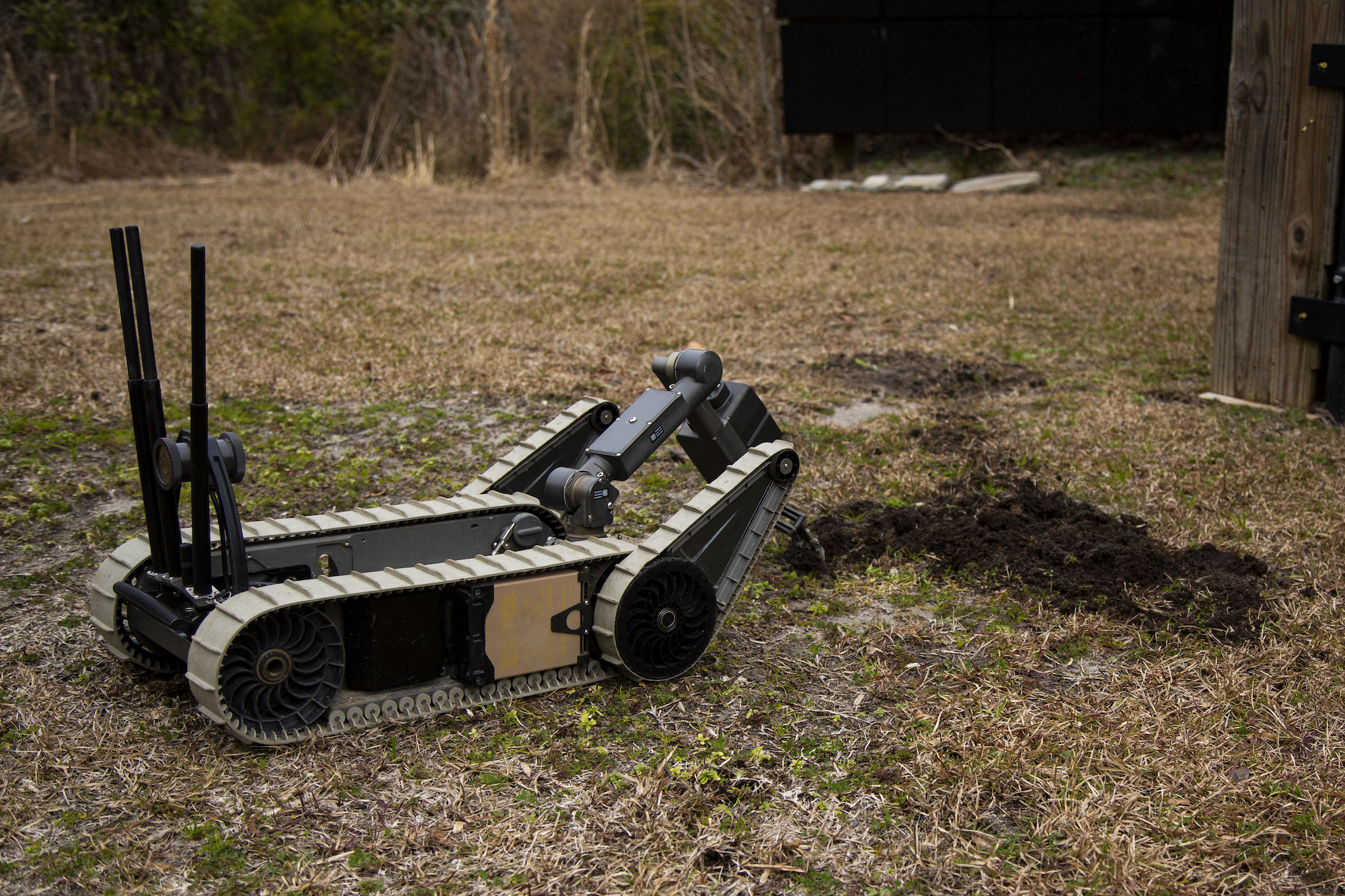

Behind the front lines of Russia’s ongoing invasion of Ukraine, robots are working to clear paths of potential explosives. This dull, deadly, and vital military task is one of the most straightforward uses of ground robotics. The mine clearing, vital to the safe movement of people and vehicles, seems like it is only happening in areas Russia feels it can safely operate, highlighting the limit of short-range remote piloting for robots in wars.
The key machine here is the Uran-6, a remotely piloted tracked robot used for demining. Russian forces used Uran-6 demining robots in Syria, as a way to clear roadside explosives. In a video shared by Russia’s Izvestia paper, an Uran-6 can be seen driving along a dirt road in what is claimed to be a location outside Mariupol in occupied Ukraine. The machine carries a heavy cylinder in front of it, which sets off explosions as it passes over landmines.
Mariupol is a Ukrainian city that saw brutal fighting for over two months. It was isolated from other Ukrainian forces while gradually besieged and cleared of defenders by Russian forces, all with civilians still caught in the crossfire. The last Ukrainian forces in the city surrendered to Russia on May 17, and other released videos have shown Uran-6s robots deployed to clear the fortified beaches of Mariupol’s Azov coast.
[Related: The tanks, rockets, and other weapons that Russia has in its arsenal]
“Russian state media is showing Uran-6 work to demonstrate that the country’s military is using modern, sophisticated equipment,” says Samuel Bendett, an analyst at the Center for Naval Analysis and adjunct senior fellow at the Center for New American Security.
But those videos, filmed and released by Russia, also highlight an obvious limit of the tech.
“We see limited Uran-6 UGV use, since the operator has to be relatively close to the vehicle – no more than several hundred feet – and so Uran-6 is used when the Russian or Russia-allied forces have secured the area and there is no danger from Ukrainian attacks,” says Bendett.
Demining by robot sweep can provide some initial safety on roads, allowing forces to move through them with minimal risk. But initial sweeps can miss well-hidden or inconveniently placed bombs, and the full work of clearning an area of explosives after combat can take years and in some cases even decades. It is likely that parts of Ukraine, especially in the Russian-held Donbas region of Eastern Ukraine, will still need to be cleared extensively.
Prior to Russia’s February 24 invasion of Ukraine across three fronts, Ukraine had, since 2014, waged a war to regain control of self-declared separatist republics in the Donbas. The constant state of conflict saw both sides firing artillery and launching bombs across static defensive lines, all while the conflict was monitored by foreign observers tracking ceasefire violations. Some of the former front lines are now firmly in Russian-controlled territory, meaning any explosives fired by either side and not safely cleared pose an enduring risk to Russian forces.
“As the Russian forces continue their slow advance across the Ukrainian territory, it’s likely that the MOD [Ministry of Defense] will be showing additional Uran-6 uses in its promo videos,” says Bendett. “At the same time, there is plenty of evidence that the bulk of demining is actually done by human sappers, who have to conduct ‘old school’ on-foot identification and destruction of mines, munitions and other [unexploded ordnance].”
[Related: Ukraine’s answer to Russian tanks involves a classic tactic: metal ‘hedgehogs’]
Mine-clearing is extensive and labor-intensive work. Even when done by robots like Uran-6, it is still a human who directs and routes the robot to where it needs to sweep. While this is an essential task for establishing safe operation within one’s side of control, the presence of uncleared areas can limit the flow of ammunition and other supplies forward to soldiers after an advance.
The short distance between the human operator and mine-clearing robot means that while the operator can be safely distant from any detonated landmines, the human is still vulnerable to attack from hostile forces. As the war in Ukraine grinds to a battle determined by artillery and the effects of attrition, the areas in which Uran-6 can be safely operated diminish. Soldiers may be willing to risk a robot in the face of incoming artillery or rockets, but trained operators of the system will be less likely to place themselves in any more danger than already comes with the job.
“So despite Russian MOD’s talk of using a growing number of robotic systems to safeguard humans lives and make missions more effective – its main goal for military autonomy and AI – it will be awhile before this technology is present in numbers large enough to phase out the sapper’s dangerous ground work,” says Bendett.
